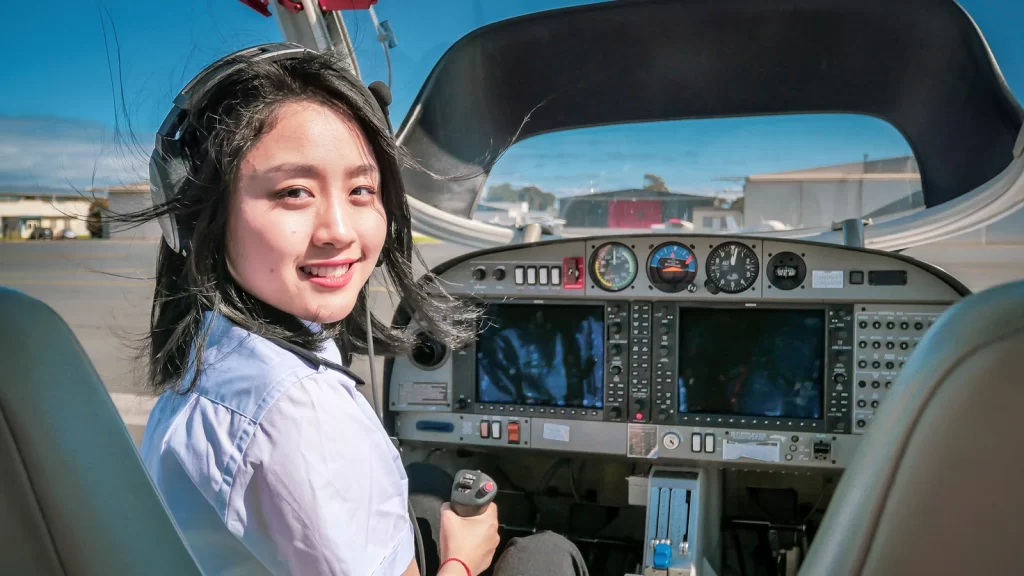With so many different types of aviation qualifications out there, which one should you choose? And which Melbourne flight school do you approach? These can be tricky questions to answer, so let us help you out.
If you simply want to get airborne and experience the thrill of piloting your own plane, then a Recreational Pilot Licence (RPL) is where you start. It comes with some restrictions such as the type of plane you are qualified to fly and how many nautical miles you can travel from your departure aerodrome. Building on that is the Private Pilot Licence (PPL) which adds on navigation training, enabling you to fly anywhere in Australia.
But if you aspire to fly planes professionally, then you’ll need a Commercial Pilot Licence (CPL). This can also be achieved by completing a Diploma of Aviation, which is a fantastic option. But why is completing a Diploma such a good option for aspiring career pilots? Read on to learn more!
Understanding your Options
At Learn To Fly’s Melbourne flight school, we pride ourselves on not simply training pilots, but producing future captains. We offer two Diploma of Aviation courses – the AVI50222 Diploma of Aviation (Commercial Pilot Licence – Aeroplane) and the AVI50519 Diploma of Aviation (Instrument Rating) course. Please note that the course code for the Commercial Pilot Licence Diploma has changed recently from AVI50219 to AVI50222.
The Diploma of Aviation courses commence at several intakes throughout the year – January, April, July and October. Applications for the October 2022 cohort have just closed, with enrolments now open for the January 2023 intake.
As approved courses on the Commonwealth Register of Institutions and Courses for Overseas Students (CRICOS), both the AVI50222 and AVI50519 courses allow overseas students to apply for a student visa. Completing the required training to obtain a CPL in Australia is very difficult to achieve for overseas students without this visa.
AVI50222 Diploma of Aviation (Commercial Pilot Licence – Aeroplane)
If you wish to make flying your career, then the AVI50222 Diploma of Aviation (Commercial Pilot Licence – Aeroplane) is the course for you. The training requires little to no experience prior to course commencement, and follows CASA Part 142 syllabus. In addition to the standard CASA training syllabus, the course features extra modules designed to better prepare students for entering and working in the aviation industry.
Throughout the course you will achieve a Recreational Pilot Licence (RPL), Private Pilot Licence (PPL) and finally the Commercial Pilot Licence (CPL) and Diploma of Aviation (Commercial Pilot Licence – Aeroplane).
AVI50519 Diploma of Aviation (Instrument Rating) course
The AVI50519 Diploma of Aviation (Instrument Rating) course combines multi-engine and instrument training, which is a compulsory requirement for many aviation careers, including that of airline pilot.
The syllabus offers CASA Part 142 Multi-Engine Class Rating and Multi-Engine Instrument Command Rating (MECIR) training, which is completed in both simulators and real aircraft. Receive instruction in our world class ALSIM AL42 simulator, which is a full cockpit synthetic trainer replicating the Diamond DA42 aircraft.
As with the AVI50222 course, there is additional learning included that specifically helps students to better transition from training to actually working as a professional pilot. Holding a Commercial Pilot Licence is a prerequisite for commencing this Diploma.
VET Student Loans (VSL)
Both of our Diploma courses have Vet Student Loans (VSL) available to support eligible students. This is a Commonwealth program that assists suitable candidates with a loan to cover tuition fees and the ability to repay the funds gradually once employed. You can find out more on our VSL page here: https://learntofly.com.sg/vet-student-loans/
Further Training – Griffith University Bachelor of Aviation
Students that have completed both the AVI50222 and AVI50519 Diploma of Aviation have the opportunity to join the renowned Griffith University Bachelor of Aviation program with advanced standing via an articulation pathway.
Our 2 Diploma courses allow you to obtain 80 credit points, meaning that you only need a further 160 to obtain the Bachelor of Aviation. Essentially, this pathway gives you the opportunity to complete 5 highly-regarded aviation qualifications (Commercial Pilot Licence, MECIR, 2 x Diploma of Aviation and Bachelor of Aviation certificates) in just 3 years.
A World of Piloting Possibilities
For local students, the option to apply for VSL makes an aviation career more accessible. For overseas students, the ability to apply for a student visa allows them to study more easily in Australia. Regardless of your background, a Diploma of Aviation will open up a world of piloting possibilities to you.
The qualifications themselves are well highly regarded within the industry, and the additional training provided on top of the standard pilot licence syllabus to better prepare you for your career is a great advantage to have. If you have a dream of a career in the skies flying as a professional pilot, then make it a reality and visit our Melbourne flight school to learn more about enrolling in a Diploma of Aviation.

















